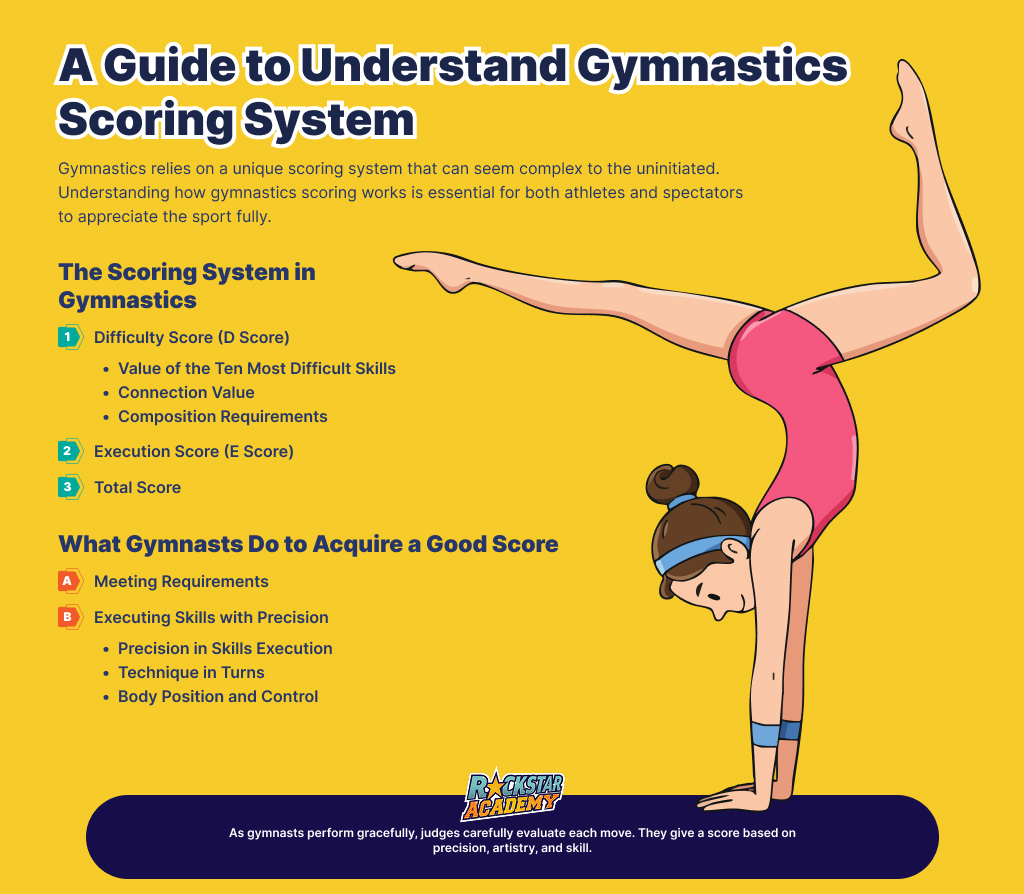A Guide to Understand Gymnastics Scoring System

Gymnastics relies on a unique scoring system that can seem complex to the uninitiated. Understanding how gymnastics scoring works is essential for both athletes and spectators to appreciate the sport fully.
The gymnastics scoring system can seem complex at first glance, but breaking it down into its fundamental components can make it more comprehensible. This guide aims to elaborate the gymnastics scoring system which can help you appreciate the intricacies and precision that define this remarkable discipline.
The Scoring System in Gymnastics
Gymnastics scoring follows a structured system designed to evaluate routines based on difficulty and execution. Understanding this scoring system is crucial for both gymnasts and spectators to appreciate the nuances of the sport.
1. Difficulty Score (D Score)
The Difficulty Score, often referred to as the D Score, assesses the complexity and risk of a gymnast's routine. Points are awarded based on the difficulty and variety of skills performed. Here’s how it works:
- Value of the Ten Most Difficult Skills
Gymnasts aim to include the most challenging skills in their routines to maximize their Difficulty Score. Each skill is assigned a specific point value based on its difficulty level, ranging from A (easiest) to H (most difficult).
The total value of the ten highest-scoring skills in the routine contributes significantly to the D Score.
- Connection Value
Connecting skills seamlessly enhances the routine’s flow and increases the D Score. Judges award additional points for skill combinations that are performed without pauses or extra steps between movements.
Effective connections demonstrate a gymnast’s ability to maintain momentum and fluidity throughout their routine.
- Composition Requirements
The gymnastics Code of Points outlines specific composition requirements that must be met to achieve a high D Score. These may include mandatory elements such as acrobatic series, dance elements, and balance skills.
Meeting composition requirements demonstrates a gymnast’s versatility and adherence to the technical guidelines of the sport.
2. Execution Score (E Score)
The Execution Score measures how well a routine is performed. It starts with a base value of 10.0 points, which represents a perfect performance. Throughout the routine, judges deduct points for errors such as form breaks, steps on landings, or falls.
Minor errors typically result in deductions of 0.1 points, while more significant mistakes, like a fall, can lead to deductions of up to 0.8 points.
A panel of six judges evaluates each routine independently, and the final E Score is derived by averaging the scores of the four middle judges after discarding the highest and lowest scores.
This ensures fairness and accuracy in evaluating the gymnast's execution quality across different perspectives.
3. Total Score
The Total Score in gymnastics combines the Difficulty Score (D Score) and the Execution Score (E Score) to determine the final outcome of a routine: Total Score = D Score + E Score - Penalties
Achieving a high Total Score requires balancing a challenging routine (high D Score) with flawless execution (high E Score). Gymnasts and coaches strategize to maximize both components while adhering to competition rules and guidelines.
What Gymnasts Do to Acquire a Good Score
To achieve a good score in gymnastics, athletes employ several strategies and practices aimed at maximizing their performance and impressing judges. Here are key actions gymnasts take to acquire a good score:
A. Meeting Requirements
Gymnasts must fulfill specific requirements outlined in the Code of Points to maximize their scores. This includes incorporating a variety of skills that demonstrate strength, flexibility, and technical mastery.
Each routine must adhere to prescribed elements such as acrobatic skills, dance elements, and connections between skills.
By meeting these requirements, gymnasts lay the foundation for a competitive routine that balances difficulty with execution quality.
B. Executing Skills with Precision
Gymnasts aim for perfection in executing skills, minimizing deductions by focusing on the following aspects:
- Precision in Skills Execution
Gymnasts aim for flawless execution of each skill. Judges scrutinize details such as the height and form of jumps, leaps, and turns.
For example, insufficient height on jumps or leaps can lead to deductions of up to 0.2 points, while failure to point toes properly might result in a deduction of 0.05 points.
Leg or knee separations during skills can incur deductions of up to 0.2 points, emphasizing the importance of maintaining clean lines and precise movements throughout the routine.
- Technique in Turns
When performing turns on floor or beam, judges assess whether the gymnast completes the turn as required (e.g., half or full turn) and maintains proper form throughout.
This includes executing the turn in high relevé (on the balls of the feet) with a tight body position. Deviations from these standards can lead to deductions based on how well the gymnast meets these criteria.
- Body Position and Control
Throughout the routine, gymnasts must demonstrate control over their body positions, maintaining straight lines, pointed toes, and minimal form breaks. Judges evaluate how well gymnasts maintain these positions during transitions between skills and throughout choreographed sequences.
Achieve Your Highest Score Yet!
As gymnasts perform gracefully, judges carefully evaluate each move. They give a score based on precision, artistry, and skill. To help you improve, explore the exciting world of gymnastics program at Rockstar Academy's renowned Sports & Performing Arts Academy!
Our gymnastics classes are designed to inspire and challenge athletes of all levels, from beginners to aspiring champions.
Led by experienced coaches, our program emphasizes skill development, strength training, and artistic expression, preparing students for success in Gymnastics Testing and other competitions such as Elite Championships and RockOlympics.
To experience the difference yourself, we're offering a free trial of our gymnastics program. Discover the benefits of expert guidance, state-of-the-art facilities, and a supportive community dedicated to your growth and achievement. Don't miss this opportunity to unleash your potential with us at Rockstar Academy!

FAQ
How do you score in gymnastics?
In gymnastics, scoring is based on two main components: Difficulty Score (D Score) and Execution Score (E Score). The D Score reflects the complexity of the routine, while the E Score evaluates its execution quality.
How do you win in gymnastics?
Winning in gymnastics is determined by achieving the highest Total Score, which combines the Difficulty Score and Execution Score. Athletes strive for precision in executing skills, minimizing deductions, and showcasing artistic expression to score competitively.



